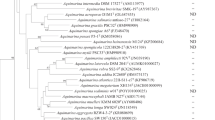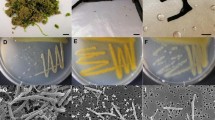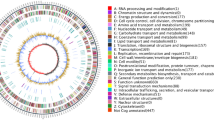Abstract
The continued research in the isolation of novel bacterial strains is inspired by the fact that native microorganisms possess certain desired phenotypes necessary for recombinant microorganisms in the biotech industry. Most studies have focused on the isolation and characterization of strains from marine ecosystems as they present a higher microbial diversity than other sources. In this study, a marine bacterium, W5C, was isolated from red seaweed collected from Yeosu, South Korea. The isolate can utilize several natural polysaccharides such as agar, alginate, carrageenan, and chitin. Genome sequence and comparative genomics analyses suggest that strain W5C belongs to a novel species of the Cellulophaga genus, from which the name Cellulophaga omnivescoria sp. nov. is proposed. Its genome harbors 3,083 coding sequences and 146 carbohydrate-active enzymes (CAZymes). Compared to other reported Cellulophaga species, the genome of W5C contained a higher proportion of CAZymes (4.7%). Polysaccharide utilization loci (PUL) for agar, alginate, and carrageenan were identified in the genome, along with other several putative PULs. These PULs are excellent sources for discovering novel hydrolytic enzymes and pathways with unique characteristics required for biorefinery applications, particularly in the utilization of marine renewable biomass. The type strain is JCM 32108T (= KCTC 13157BPT).



Similar content being viewed by others
References
Abt B, Lu M, Misra M et al (2011) Complete genome sequence of Cellulophaga algicola type strain (IC166). Stand Genom Sci 4:72–80. https://doi.org/10.4056/sigs.1543845
Alper H, Stephanopoulos G (2009) Engineering for biofuels: exploiting innate microbial capacity or importing biosynthetic potential? Nat Rev Microbiol 7:715–723. https://doi.org/10.1038/nrmicro2186
Auch AF, Jan von M, Klenk H-P, Göker M (2010) Digital DNA-DNA hybridization for microbial species delineation by means of genome-to-genome sequence comparison. Stand Genom Sci 2:117–134. https://doi.org/10.4056/sigs.531120
Berg JM, Tymoczko JL, Stryer L (2002) Biochemistry, 5th Edn. W. H. Freeman, New York
Bowman JP (2000) Description of Cellulophaga algicola sp. nov., isolated from the surfaces of Antarctic algae, and reclassification of Cytophaga uliginosa (ZoBell and Upham 1944) Reichenbach 1989 as Cellulophaga uliginosa comb. nov. Int J Syst Evol Microbiol 50(Pt 5):1861–1868. https://doi.org/10.1099/00207713-50-5-1861
Fang G, Rocha EPC, Danchin A (2008) Persistence drives gene clustering in bacterial genomes. BMC Genom 9:4. https://doi.org/10.1186/1471-2164-9-4
Johansen JE, Nielsen P, Sjøholm C (1999) Description of Cellulophaga baltica gen. nov., sp. nov. and Cellulophaga fucicola gen. nov., sp. nov. and reclassification of [Cytophaga] lytica to Cellulophaga lytica gen. nov., comb. nov. Int J Syst Bacteriol 49 Pt 3:1231–1240. https://doi.org/10.1099/00207713-49-3-1231
Kahng H-Y, Chung BS, Lee D-H et al (2009) Cellulophaga tyrosinoxydans sp. nov., a tyrosinase-producing bacterium isolated from seawater. Int J Syst Evol Microbiol 59:654–657. https://doi.org/10.1099/ijs.0.003210-0
Lahaye M, Robic A (2007) Structure and functional properties of ulvan, a polysaccharide from green seaweeds. Biomacromol 8:1765–1774. https://doi.org/10.1021/bm061185q
Lee I, Kim YO, Park S-C, Chun J (2015) OrthoANI: An improved algorithm and software for calculating average nucleotide identity. Int J Syst Evol Microbiol 66:1100–1103. https://doi.org/10.1099/ijsem.0.000760
Lee SB, Cho SJ, Kim JA et al (2014) Metabolic pathway of 3,6-anhydro-L-galactose in agar-degrading microorganisms. Biotechnol Bioproc Eng 19:866–878. https://doi.org/10.1007/s12257-014-0622-3
Lee SB, Kim JA, Lim HS (2016) Metabolic pathway of 3,6-anhydro-D-galactose in carrageenan-degrading microorganisms. Appl Microbiol Biotechnol 100:4109–4121. https://doi.org/10.1007/s00253-016-7346-6
Liu G, Wu S, Jin W, Sun C (2016) Amy63, a novel type of marine bacterial multifunctional enzyme possessing amylase, agarase and carrageenase activities. Sci Rep 6:415. https://doi.org/10.1038/srep18726
Lombard V, Golaconda Ramulu H, Drula E et al (2013) The carbohydrate-active enzymes database (CAZy) in 2013. Nucl Acids Res 42:D490–D495. https://doi.org/10.1093/nar/gkt1178
Ma S, Tan Y-L, Yu W-G, Han F (2013) Cloning, expression and characterization of a new ι-carrageenase from marine bacterium, Cellulophaga sp. Biotechnol Lett 35:1617–1622. https://doi.org/10.1007/s10529-013-1244-0
Mann AJ, Hahnke RL, Huang S et al (2013) The genome of the alga-associated marine Flavobacterium Formosa agariphila KMM 3901T reveals a broad potential for degradation of algal polysaccharides. Appl Environ Microbiol 79:6813–6822. https://doi.org/10.1128/AEM.01937-13
Meier-Kolthoff JP, Auch AF, Klenk H-P, Göker M (2013) Genome sequence-based species delimitation with confidence intervals and improved distance functions. BMC Bioinform 14:60. https://doi.org/10.1186/1471-2105-14-60
Mergaert J, Verdonck L, Kersters K (1993) Transfer of Erwinia ananas (synonym, Erwinia uredovora) and Erwinia stewartii to the genus Pantoea emend. as Pantoea ananas (Serrano 1928) comb. nov., respectively, and description of Pantoea stewartii subsp. indologenes subsp. nov. Int J Syst Bacteriol 43:162–173. https://doi.org/10.1111/j.1574-6968.199.tb08826.x
Mori T, Takahashi M, Tanaka R et al (2014) Draft genome sequence of Falsirhodobacter sp. strain Alg1, an alginate-degrading bacterium isolated from fermented brown algae. Genome Announc 2:e00826–e00814. https://doi.org/10.1128/genomeA.00826-14
Park S, Oh K-H, Lee S-Y et al (2012) Cellulophaga geojensis sp. nov., a member of the family Flavobacteriaceae isolated from marine sand. Int J Syst Evol Microbiol 62:1354–1358. https://doi.org/10.1099/ijs.0.033340-0
Parte S, Sirisha VL, D’Souza JS (2017) Biotechnological applications of marine enzymes from algae, bacteria, fungi, and sponges. Adv Food Nutr Res 80:75–106. https://doi.org/10.1016/bs.afnr.2016.10.005
Pati A, Abt B, Teshima H et al (2011) Complete genome sequence of Cellulophaga lytica type strain (LIM-21). Stand Genom Sci 4:221–232. https://doi.org/10.4056/sigs.1774329
Ramos KRM, Valdehuesa KNG, Liu H et al (2014) Combining De Ley–Doudoroff and methylerythritol phosphate pathways for enhanced isoprene biosynthesis from D-galactose. Bioproc Biosyst Eng 37:2505–2513. https://doi.org/10.1007/s00449-014-1228-z
Sun C, Fu G-Y, Zhang C-Y et al (2016) Isolation and complete genome sequence of Algibacter alginolytica sp. nov., a novel seaweed-degrading bacteroidetes bacterium with diverse putative polysaccharide utilization loci. Appl Environ Microbiol 82:2975–2987. https://doi.org/10.1128/AEM.00204-16
Tamura J-I, Hasegawa K, Kadowaki K et al (1995) Molecular cloning and sequence analysis of the gene encoding an endo α-1,4 polygalactosaminidase of Pseudomonas sp. 881. J Ferment Bioeng 80:305–310. https://doi.org/10.1016/0922-338X(95)94196-X
Whitman WB (2015) Bergey’s manual of systematics of archaea and bacteria. https://doi.org/10.1002/9781118960608
Yin Y, Mao X, Yang J et al (2012) dbCAN: a web resource for automated carbohydrate-active enzyme annotation. Nucl Acids Res 40:W445–W451. https://doi.org/10.1093/nar/gks479
Yun EJ, Lee S, Kim HT et al (2014) The novel catabolic pathway of 3,6-anhydro-L-galactose, the main component of red macroalgae, in a marine bacterium. Environ Microbiol 17:1677–1688. https://doi.org/10.1111/1462-2920.12607
Funding
This work was supported by the Basic Science Research Program and Korea Research Fellowship Program through the National Research Foundation of Korea (NRF) funded by the Ministry of Science and ICT (Nos. 2015H1D3A1062172 and 2016R1C1B1013252), and the Ministry of Education (No. 2009-0093816).
Author information
Authors and Affiliations
Corresponding author
Ethics declarations
Competing interest
The authors declare that they have no competing interests.
Ethical Approval
This article does not contain any studies with human participants or animals performed by any of the authors.
Electronic Supplementary Material
Below is the link to the electronic supplementary material.
Rights and permissions
About this article
Cite this article
Valdehuesa, K.N.G., Ramos, K.R.M., Moron, L.S. et al. Draft Genome Sequence of Newly Isolated Agarolytic Bacteria Cellulophaga omnivescoria sp. nov. W5C Carrying Several Gene Loci for Marine Polysaccharide Degradation. Curr Microbiol 75, 925–933 (2018). https://doi.org/10.1007/s00284-018-1467-3
Received:
Accepted:
Published:
Issue Date:
DOI: https://doi.org/10.1007/s00284-018-1467-3




